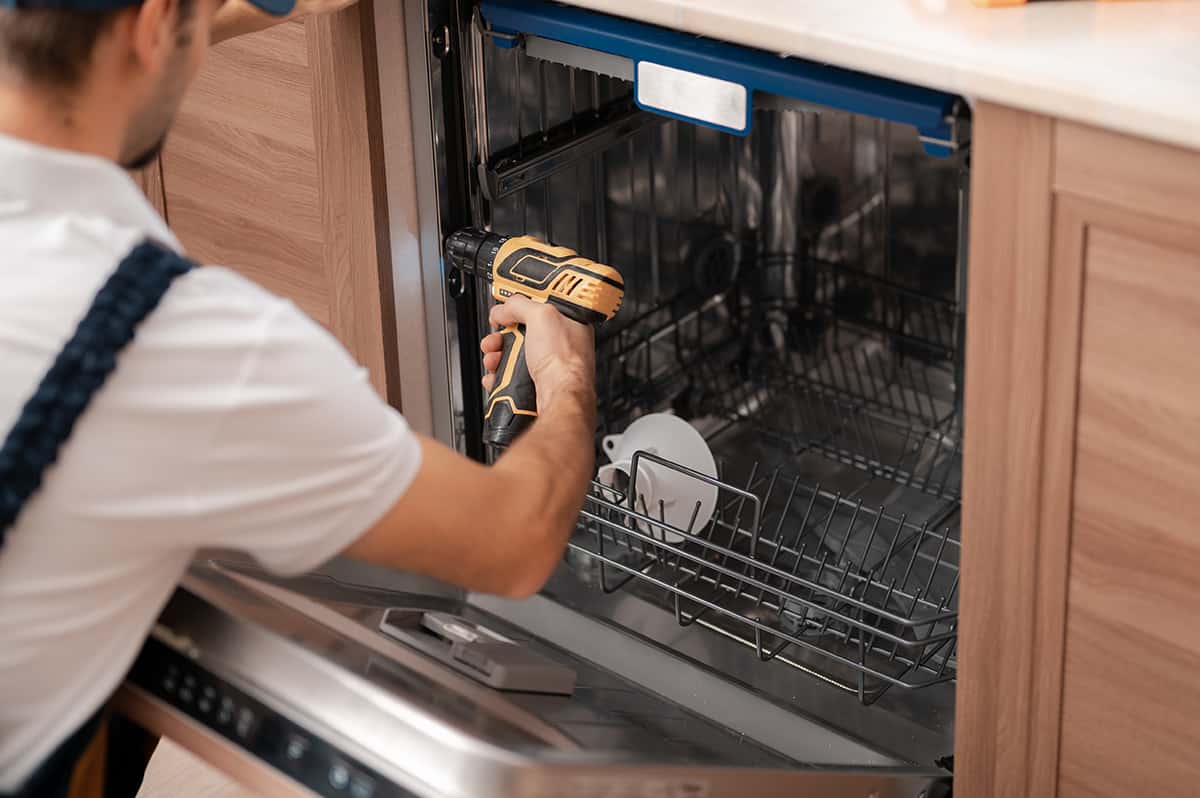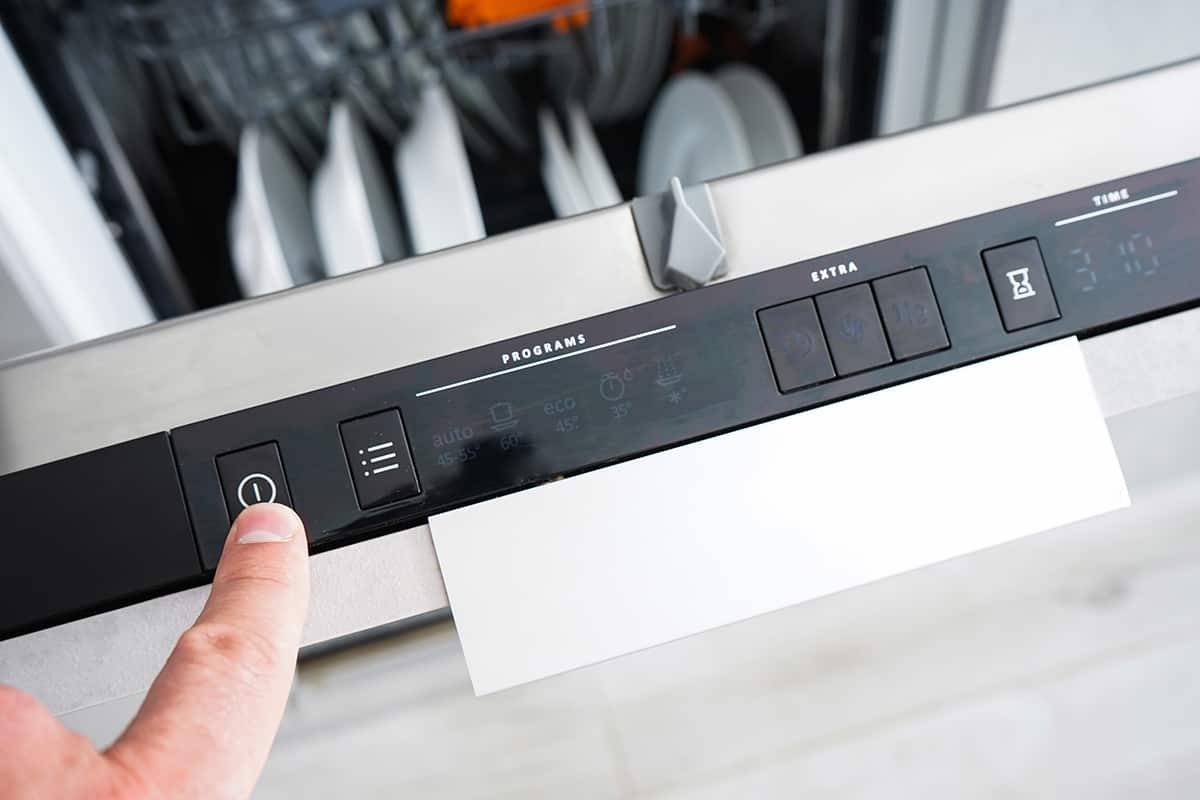With a trusty dishwasher, you can clean and rinse mountains of dirty dishes in a fraction of the time it would take to wash them by hand.
However, like any kitchen appliance, dishwashers are prone to failure over time, especially in aging models. So, if your dishwasher has power but won’t start a wash cycle, what should you do?
Here’s a list of parts you need to examine when your dishwasher won’t start: power cord, door latch, start button, control panel, timer control, selector switches, thermal fuse, heating element, and drive motor. In extreme cases, you might need to call a professional technician to solve your dishwasher’s problem.
So, how do you go about examining each of these components, and when do you know it’s time to seek professional help? I’ll explain how to troubleshoot a malfunctioning dishwasher and more in the following sections.
9 Things to Check When Your Dishwasher Won’t Start
If your dishwasher can’t turn on, even when there’s power, here are the 9 things you need to examine before doing anything else.
1. Check the plug
This might sound like a simple solution at first, but more times than not, people forget to plug in their dishwashers or flip on the circuit breaker. So, even if you think there’s power running into the machine, you should still check the power cord.
In very rare instances, hardwired cables may have disconnected from the power source. In which case, you should shut off the circuit breaker and inspect the cable carefully. If you don’t have any technical know-how on how the cable should look, speak to a professional repairman.
2. Inspect the door latch
Dishwashers are designed to not turn on when their door latches are disengaged. So, if your dishwasher looks like it has power but cannot turn on, the next thing you should do is inspect the door and latching mechanism.
As time goes by, the microswitch found inside the door latch will wear down, making it unable to read whether the door is really shut or not. The latch itself might also be faulty, in which case you will have to purchase and install a replacement.
Oftentimes, improperly shutting the door can lead to what looks like a loss of power. In some rarer cases, old food remnants might have found their way into the latch, making it impossible to close completely.
You can also examine the child safety lock. An active lock might prevent you from inputting new settings and even turning the machine on and off.
3. Inspect the start button
Many times, you might find yourself only hitting the power and/or start buttons on your dishwasher. Over time, the buttons might wear down or a cable might have become frayed or loosened.
The only reliable way to examine the start button is to use a multimeter. Check to see whether it can detect a running current through the button.
If it can’t, you will have to repair the start button on your own or hire a technician to do it for you.
If your dishwasher is over 7 years old at this point, the better option might be to replace the unit entirely.
4. Examine the control panel
Again, as time goes on, the control panel might lose functionality due to wear and tear. This is especially common in older models or ones that were purchased second-hand. One clear sign that your control panel is faulty is the backlight LEDs do not turn on when pressing buttons.
In this case, your dishwasher might be completely fine, but the control panel might have lost its lighting function. However, it’s safer to examine the entire control panel for any faults, especially if you cannot input new wash cycles.
In most cases, it would be better to replace the dishwasher than to repair a broken control panel, especially if you’ve had the machine for several years now.
5. Check the timer control
The timer control is the part of your dishwasher that is in charge of determining how long a wash cycle should take. The thing about a faulty timer control is that it will prevent the machine from turning on entirely.
You will have to remove the control panel to see whether or not the connecting cables are where they should be. If they aren’t, you might have to hire a technician to fix the timer control for you.
However, if the timer control is broken completely, it can cost quite a lot to replace it. In which case, it would make more sense to replace the dishwasher with a higher-quality model.
6. Check the selector switches
The selector switches are a component found in the dishwasher’s control panel. These switches are in charge of activating the different cycle options. If the selector switches’ lights don’t turn on, that means a cable might have disconnected somewhere in the back.
Replacing the switches can be challenging since you will have to do more than swap out the worn-out switches with new ones. The replacements are fairly inexpensive, but installing them might require the help of a professional.
7. Check for a blown thermal fuse
Inside your dishwasher is a thermal fuse, which is in place to prevent the control panel from overloading. A thermal fuse requires replacing once every 12 months or so, depending on how often you use the machine.
A blown fuse will prevent electricity from reaching the control panel, stopping your dishwasher from even turning on. You can replace the thermal fuse on your own if you already have a replacement unit on hand.
8. Inspect the heating element
Damaged or faulty heating elements can cause your dishwasher to shut off and not turn back on.
You’ll notice when the heating element has malfunctioned as the dishwasher will remain on its current cycle until you turn the unit off. After which, you cannot turn it on until you replace the heating element.
Inspect the heating element by taking off the dishwasher’s front panel. It should look similar to a horseshow with metal rods on both ends. Use a multimeter to figure out whether electricity can run through it.
Unfortunately, there is virtually no way to repair a broken heating element. Your only option is to replace it entirely. Luckily, replacements are fairly cheap, and they can last for several years with proper care.
9. Check the drive motor
The drive motor is responsible for spraying water through the spray arm. A damaged drive motor, which can happen over time, will prevent water from spraying out of the arms in the least extreme cases.
However, if the drive motor malfunctions, odds are your dishwasher won’t even turn on.
One clear sign that the drive motor is on the fritz is inexplicable drumming or humming noises. Unfortunately, if you have a failed drive motor on your hands, replacing it will set you back quite a bit—about the price of a portable dishwasher.
When Should I Call a Repair Contractor?

For those who do not want to dismantle their dishwashers to examine the aforementioned components manually, you should contact a repair contractor at your earliest convenience.
However, if you’re slightly educated on how dishwashers work, and if you can follow the troubleshooting instructions included in the owner’s manual of your dishwasher, then you might want to at least examine the components before you call a repairman.
That said, you should have all of the proper tools on hand before even thinking about taking the dishwasher apart. Without a multimeter, you won’t be able to determine which part or parts are faulty.
Should I Reset My Dishwasher?
Resetting a dishwasher only works when there’s actually power flowing through the machine. However, it won’t hurt inputting the reset sequence, just in case the dishwasher’s LED lights are the only malfunctioning part.
In every other case, since your dishwasher won’t turn on, there is no way to reset it without turning it on first. That said, it’s worth resetting the dishwasher the moment it turns back on, just to clear the cache of memory that might not have been erased automatically.
Do I Need to Replace My Dishwasher?
Whether or not you need to replace your dishwasher if it won’t turn on depends on the severity of the issue. One thing you can do is compare the cost and benefit of repairing and replacing the dishwasher.
In many of the extreme cases mentioned earlier, you might end up having to purchase a new dishwasher. The components might have been on the edge of their lifespan for several weeks or months now, and it was only a matter of time before they failed completely.
The best thing you can do is speak to a repair contractor and ask for their advice. If they think your dishwasher is past its prime, it might not be worth salvaging by installing new components. Assuming your dishwasher hasn’t hit the 3-year mark yet, you might be able to bring it back to life with simple repairs.
If you want to learn more about dishwasher issues, check out these.






